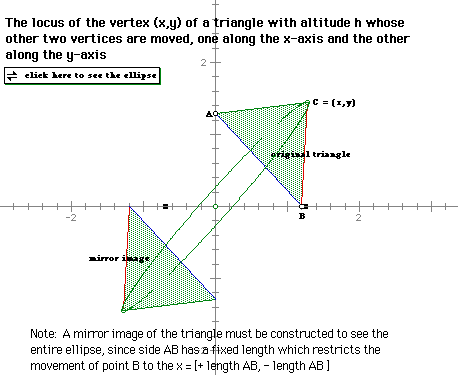
Consider the graphs generated from the following parametric equations the graphs of which appear below. Can you guess which equation generates a circle of radius one and which one generates a circle of radius two?
![]() ,
, ![]()

Since the values for x and y are based on the angular value
t, x = a cos (t) and y = b sin (t), if a = b we have ![]() simplifying
and using trigonmetric identities we have
simplifying
and using trigonmetric identities we have ![]() .
Hence if a = b we have a circle with radius a.
.
Hence if a = b we have a circle with radius a.
If a > b in the parametric equations ![]() ,
then an ellipse centered at the origin with a major axis of length
2a units and a minor axis of length 2b units is generated. An
example follows.
,
then an ellipse centered at the origin with a major axis of length
2a units and a minor axis of length 2b units is generated. An
example follows.
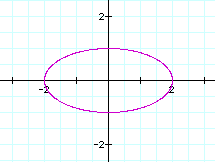
If a < b in the parametric equations ![]() ,
then an ellipse centered at the origin with a major axis of length
2b units and a minor axis of length 2a units is generated. An
example follows.
,
then an ellipse centered at the origin with a major axis of length
2b units and a minor axis of length 2a units is generated. An
example follows.
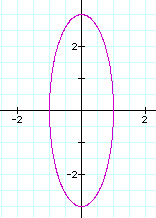
Although, at first glance, the graph of the parametric equation
![]()

may look like a line it is not! It is actually a degenerate ellipse. Cosider the case where a=b and h = 2
Consider the following system of parametric equation where
a = b and h = 2: ![]()
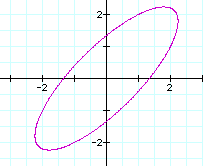
Note that the major axis is on the line y=x. This will be the case regardless of the relationship between a and b as the following example will illustrate.
.gif)
Note that the major axis in this example is still the line y = x.
Can you guess why the major axis in the same in both of these example? Perhaps one more example will help.
![]()

Note in this example the h values are not the same, hence the major axis is not y = x. In addition the orientation will change if the h value is less than zero as the example below will illustrate.
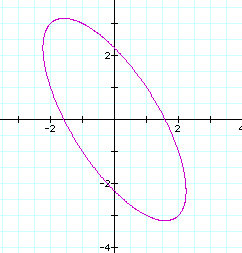
The parametric equations of the form ![]() describe
the locus of the vertex (x, y) of a triangle with altitude h whose
other two vertices are moved, on along the x-axis and the other
along the y-axis. To see the ellipse generated using GSP click
HERE
or create one yourself using the following sample.
describe
the locus of the vertex (x, y) of a triangle with altitude h whose
other two vertices are moved, on along the x-axis and the other
along the y-axis. To see the ellipse generated using GSP click
HERE
or create one yourself using the following sample.
